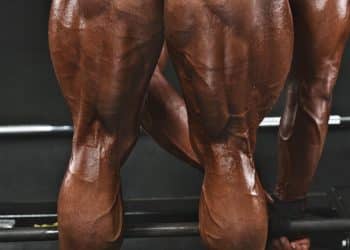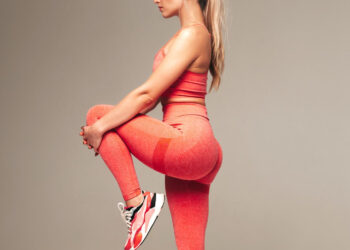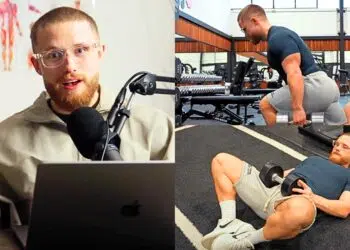Good morning is a compound functional movement that helps build bigger and stronger hamstrings, glutes, and lower back. It is a squat and deadlift hybrid that mimics a Romanian deadlift but with the weight placed on the shoulders.
As a personal trainer with seven years in the trenches, I can attest that most find developing the lower body posterior chain muscles challenging as they cannot look at them directly in the mirror while performing good mornings. It makes it more challenging to establish a mind-muscle connection and achieve the desired training results. However, posterior chain training cannot be overlooked.
A systematic review and meta-analysis comparing posterior chain resistance training (PCRT) to general exercise for treating chronic low back pain (CLBP) found that PCRT was more effective in reducing pain, improving the level of disability, and increasing muscle strength without increasing the number of adverse events. (1)
This article covers 11 top good morning alternatives for people who have difficulty performing good mornings or want to add more variety to their training regime.
11 Best Good Morning Alternatives
Here is a mix of bodyweight, resistance band, cable, dumbbell, barbell, and kettlebell exercises suitable for people of varying experience levels:
Romanian Deadlift
The Romanian deadlift is one of the most popular hip-hinge exercises that biases the hamstrings, glutes, and lower back. While performing this exercise, most people focus on lowering the weights to the floor. However, this is where the RDLs differ from the conventional barbell deadlifts.
Level Up Your Fitness: Join our 💪 strong community in Fitness Volt Newsletter. Get daily inspiration, expert-backed workouts, nutrition tips, the latest in strength sports, and the support you need to reach your goals. Subscribe for free!
During RDL eccentrics, you must actively push your hips toward the wall behind you to optimally load the hamstrings and glutes. Keeping your legs perpendicular to the floor will transfer most of the tension to the back.
How To:
- Stand upright with a hip-width stance.
- Grab a barbell with a shoulder-wide overhand grip and hold it against your thighs.
- While maintaining slight knee flexion, slowly lower the barbell toward the floor by hinging at the hips and pushing your hips back.
- The barbell should be at mid-shin level at the bottom of the range of motion.
- Pause and contract your hamstrings and glutes.
- Explode back to the starting position by extending your hips and driving them forward.
Pro Tip: In my experience, most beginners fare better performing the RDLs with dumbbells as it allows a more comfortable arm position.
Master the RDLs with this in-depth guide!
Single-Leg Deadlift
This unilateral compound exercise is incredibly effective for fixing posterior chain strength and muscle imbalances. I have my beginner clients perform this exercise while holding a dumbbell in one hand while the other hand grasps a stable object like a cable pulley station for balance and support.
More experienced exercisers can perform the single-leg deadlift while holding a dumbbell in each hand.
How To:
- Stand erect while holding a dumbbell in each hand.
- Lift your left foot off the floor by slightly flexing your knee; hold the foot behind your body.
- Slowly lower the dumbbells to the floor by hinging at the hips and raising your left leg toward the ceiling for balance.
- Hold the hamstrings and glutes in the fully extended position at the bottom for a second.
- Reverse the motion to return to the starting position.
- Repeat for recommended reps on one side before switching to the other.
Pro Tip: Drive your hips backward on eccentrics for greater target muscle stimulation.
Check out our dedicated single-leg deadlift guide!
Cable Pull Through
This exercise is often overlooked in a lower body workout. Using a cable helps maintain constant tension on the target muscles, which can increase the time under tension and promote hypertrophy.
How To:
- Connect a rope attachment to a cable pulley adjusted at the lowest setting.
- Stand with your back toward the pulley so that the rope attachment is placed between your feet.
- Grab the ropes with a neutral grip (palms facing each other) and stand upright. Hold the rope attachment between your legs.
- Take a big step forward so the weight is engaged. Stand with a shoulder-wide stance to ensure optimal balance.
- Slowly hinge at the hips while maintaining a slight knee flexion, and thread your arms through your legs to lower the cable toward the pulley.
- Pause at the bottom of the ROM for a deep hamstring stretch.
- Extend your hips and drive them forward to return to the starting position.
Pro Tip: I have my clients employ 3-second eccentrics on this exercise to maximize muscle activation and promote hypertrophy. (2)
Learn about the muscles worked, benefits, and cable pull-through alternatives!
Nordic Curl
The Nordic curl is among the most challenging good morning alternatives, especially when performed with a strict form. However, it is one of the most effective for promoting hamstring hypertrophy. (3)
How To:
- Kneel on a Nordic bench and place your ankles under the leg pads.
- Cross your arms in front of your chest.
- Drive your legs into the pads to engage your hamstrings and glutes.
- Slowly extend your knees to lower your torso toward the floor.
- Break the fall with your hands when your chest is a few inches off the floor.
- Contract your hamstrings and glutes to return to the starting position.
- Repeat for recommended reps.
Pro Tip: If you don’t have access to a Nordic bench at your gym, you can place your lower legs under a loaded barbell and use quarter plates to keep the barbell from rolling.
Decode the Nordic curls with this article!
Glute Bridge
The glute bridge is among the most beginner-friendly good morning alternatives to train the hamstrings and glutes. In the training regimens I design for my advanced clients, I incorporate weighted glute bridges to ensure optimal stimulation for strength and muscle gains.
How To:
- Lie on the floor with your knees flexed and feet placed shoulder-width apart on the ground.
- Place your arms at your sides with your palms on the floor.
- Drive your heels into the ground to lift your hips toward the ceiling.
- Your body, from shoulders to knees, should be in a straight line at the top.
- Pause and contract your glutes and hamstrings at the top of the range of motion.
- Slowly return to the starting position.
Pro Tip: Place a dumbbell across your hip creases for added resistance. Ensure you hold the weight throughout the exercise to prevent it from sliding down during the concentric phase.
Level Up Your Fitness: Join our 💪 strong community in Fitness Volt Newsletter. Get daily inspiration, expert-backed workouts, nutrition tips, the latest in strength sports, and the support you need to reach your goals. Subscribe for free!
Here is everything you need to know about glute bridges!
GHD Hip Extension
GHD machines are an excellent tool for training the posterior chain muscles through the full range of motion. The GHD hip extension mimics the hip hinge motion of the good mornings and effectively loads the hamstrings and glutes.
How To:
- Adjust the GHD machine so your hips are clear of the hip pads.
- Mount the bench and insert your ankles inside the foot pads.
- Your body should be parallel to the floor in the starting position.
- Cross your arms in front of your chest and slowly lower your torso until it is almost perpendicular to the floor.
- Feel a deep stretch in your hamstring and glutes at the bottom.
- Squeeze the target muscles to return to the starting position.
Pro Tip: You can use the hyperextension machine if you don’t have a GHD bench at your gym. Ensure that you go as low as possible on the eccentrics to fire up the hammies.
Check out the best GHD exercises!
Reverse Hyperextension
The reverse hyperextension is a potent machine for people with difficulty performing hip-hinge exercises.
How To:
- Adjust the hyperextension machine so your hips are just off the bench.
- Grab the handles with both hands using a neutral grip. Your torso should be on the bench and parallel to the floor.
- Insert your lower legs into the machine’s belt so it is wrapped around your calves.
- Your hips should be flexed at 90 degrees at the starting position.
- Contract your glutes and hamstrings to lift your legs toward the ceiling. Go as high as you comfortably can and pause at the top of the range of motion.
- Slowly return to the starting position.
Pro Tip: I see so many people swing their legs like a pendulum while performing this exercise. Doing this can put undue stress on your lower back and increase injury risk. Use a slow and controlled motion to get the best bang for your buck.
Here is our reverse hyperextension dedicated guide!
Reverse Chinese Plank
Isometric exercises can help build explosive strength and muscle mass. The reverse Chinese plank might look easy, but it will set your posterior chain on fire. You will need two elevated platforms of the same height for this exercise.
How To:
- Set two flat benches around five feet apart.
- Place your heels on one bench and your shoulder blades on the other.
- Your middle and lower back and legs should be suspended between the benches.
- Contract your lower back, glutes, and hamstring to maintain your body in a straight line.
- Hold this position for as long as possible.
Pro Tip: Advanced exercisers can place a dumbbell or weight plate on their hips to make this exercise more challenging.
Kettlebell Swing
The glutes are the biggest and strongest muscle in the human body. Exercises like the kettlebell swings can help build explosive strength, which can improve overall functionality and performance.
I have my clients focus on pushing their hips backward on eccentrics to maximize hamstring and glute recruitment on this hip hinge exercise.
How To:
- Stand upright with a shoulder-wide stance while holding a kettlebell with both hands between your legs.
- While maintaining a slight bend in your knees, hinge at the hips and drive your hips backward while driving your arms through your legs and behind your body.
- Explosively extend your hips and knees and thrust your hips forward and into your arms.
- Use the momentum from the hip thrust to raise your arms to shoulder level.
- Repeat for recommended reps.
Pro Tip: I see most people use their shoulders to lift the kettlebell. The initial arm lift-off should be a result of the hip drive. Use lighter weights to drill the movement mechanics before moving onto heavier weights.
Check out our complete kettlebell swing guide here!
Hip Thrust
The hip thrust is a glute bridge variation that is usually done with a barbell. This isolation exercise is effective at loading the hamstring and glutes. However, you must squeeze the life out of the target muscles at the top of the ROM to get the most out of it.
How To:
- Sit on the floor with your back against a flat bench. Place your feet shoulder-width apart on the floor.
- Position a loaded barbell across your hip crease.
- Drive your hips toward the ceiling until your knees are flexed at 90 degrees.
- Hold the isometric contraction for at least a second.
- Slowly return to the starting position.
- Rinse and repeat.
Pro Tip: Use a wider-than-shoulder-width stance to bias the inner side of the hamstrings and glutes and a narrow foot placement to load the outer side of the target muscles.
Banded Glute Kickback
These are among the best good morning alternatives to target the glutes and upper part of the hamstrings. I have my personal training clients hold the isometric contractions for 3-5 seconds for a deeper target muscle stimulation. You could do the same if you feel the resistance band is too light for you.
How To:
- Wrap a fabric loop resistance band around the bottom of your upper legs.
- Stand upright with a shoulder-wide stance.
- Place your hands on your hips and lean forward slightly.
- Lift your left leg off the floor and hold it behind your midline. The band should be taut at the starting position.
- While keeping your right leg steady, lift your left foot toward the wall behind you.
- Pause and contract your glutes at the top.
- Reverse the motion to return to the starting position.
- Repeat for recommended reps before switching sides.
Pro Tip: You could place your hands on a wall for support and stability.
Conclusion
Good mornings are a hip-hinge exercise that bias the hamstring, glutes, and lower back. This exercise can be intimidating for beginners who don’t want to bend over with a heavy barbell on their backs.
The 11 good morning alternatives explained in this article are suitable for people across all fitness levels.
If you have any questions about the good mornings or training your posterior chain, drop them in the comments below, and I’ll be happy to help!
References
- Tataryn, N., Simas, V., Catterall, T., Furness, J., & Keogh, J. W. L. (2021). Posterior-Chain Resistance Training Compared to General Exercise and Walking Programmes for the Treatment of Chronic Low Back Pain in the General Population: A Systematic Review and Meta-Analysis. Sports medicine – open, 7(1), 17. https://doi.org/10.1186/s40798-021-00306-w
- Azevedo PHSM, Oliveira MGD, Schoenfeld BJ. Effect of different eccentric tempos on hypertrophy and strength of the lower limbs. Biol Sport. 2022;39(2):443-449. doi:10.5114/biolsport.2022.105335
- Seymore, K. D., Domire, Z. J., DeVita, P., Rider, P. M., & Kulas, A. S. (2017). The effect of Nordic hamstring strength training on muscle architecture, stiffness, and strength. European journal of applied physiology, 117(5), 943–953. https://doi.org/10.1007/s00421-017-3583-3
Article Updates Timeline:
Our editorial team experts constantly update the articles with new information & research, ensuring you always have access to the latest and most reliable information.
February 9, 2024
Written By
Vidur Saini
Reviewed By
Editorial Team
Interested in measuring your progress? Check out our strength standards for Good Morning, Deadlift, Hip Extension, and more.








